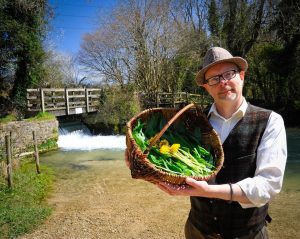This is a blog post about the tradition of St. George and the St. George’s mushroom. For details of the forthcoming St. George’s Mushroom Champagne Picnic please go here.
St. George’s day approaches (23rd April) and heralds the beginning of spring revelry. The Catholic St. George was a graft onto older stock and the slayer, or perhaps handler, of dragons is found throughout Europe, the near east and Russia today as a protector and patron saint. In earlier times he took the form of the ‘green man’, representing the rejuvinatory power of spring and the mysterious balance of light and dark, growth, decay, winter and summer that is central to the farmer’s and the forager’s year. In Orthodox Christianity as well as in Russian folk magic and even among the shamen of Siberia, the protector George is often called upon, consulted and prayed to before going ahead with any major work
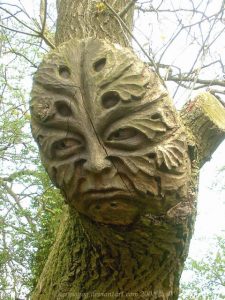
The Green Man – by Grinagog (grinagog.deviantart.com)
Al Khidr, the Green Saint of Islamic folklore is perhaps another guise assumed by George, or perhaps more accurately another echo that has come down to us via that same ancient river of belief. In the holy-land they are venerated together at one and the same shrines (for example in Bethlehem and Jerusalem) along with Elijah, bringing Jew, Christian and Muslim to enter the same places of worship. Similarly, in parts of India the cult of Kwaja Khadir is observed by both Muslim and Hindu. In some areas of Eastern Europe the festivities of Green George (Gergiovden) are marked by decking a young man in foliage resembling very much the more modern Hastings Jack in the Green and often he is paraded through the streets prior to being given a good ducking in the village pond or local river. This festival is very popular in many regions, particularly among the Romani, taking place over the feast of St. George as rendered before post-mediaeval calendrical changes on the 6th of May.
Very soon too, in English fields and meadows, it will be time to make May garlands and walk among the wildflowers of spring purely for pleasure and contentment. In the folk customs surrounding our old May-day the ‘Green One’ will be readied to marry the May Queen, his bride. In England too we have our own traditions to commemorate his life and his passing, as in the (probably now garbled) Padstow Obby ‘Oss song…
“O’ where is St. George, O’ where us he O’
He’s out in his long boat, all on the salt sea O’.
Up flies the Kite and down tails the lark O’
Aunt Ursula Birdhood, she had an old ewe
and she died in her own Park O'”
In contemplation and in honour of these cycles of time and of the year, take a walk out into the grassy meadows and limestone woods to seek the plump creamy-white fruit bodies of St. George’s mushroom. A sign given forth by the earth herself to warn us that night time frosts are now coming to a close and it is the time to be industrious in the fields.
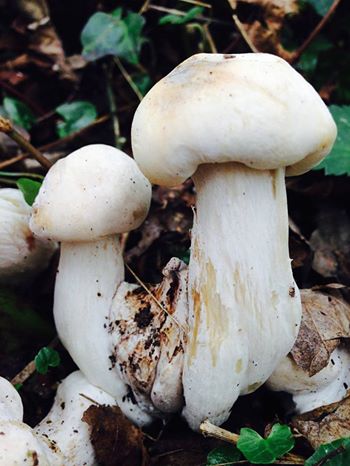
Calocybe gambosum – St. George’s mushroom
It smells pleasantly ‘floury’ (as if fresh from the miller’s wheel) and often occurs in large wheels in the turf. St. George himself was said to have been ground into flour or ‘broken on a wheel’ at his execution and spread upon the land by his Roman captors, as commemorated in the lines of the old English mummers play “I’ll grind yer bones to dust and send you to the Devil to make mince pie crust”.
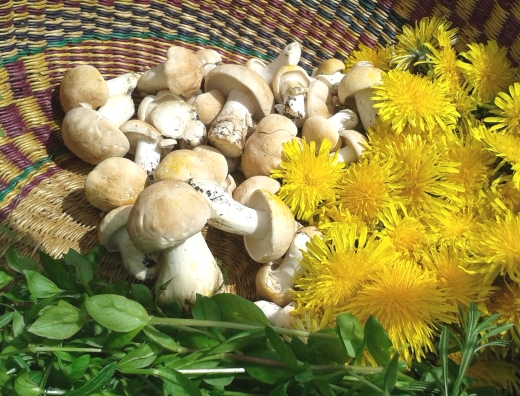
St. George’s, chickweed and dandelion blooms are a good combination!
Be very careful to identify it correctly as there are some other whitish mushrooms that are very poisonous. St. George’s mushroom is very tasty though and highly sought after and prized in Italy and France. In Britain it has undergone something of a revival in recent years and it is to be found on the menu’s of many of the better restaurants and gourmet pubs. It can be sautéd in butter and goes well with shallots, asparagus, bacon, eggs and dandelion blossoms. It can also be pickled. The delicate complex flavour is easily overpowered by bolder ones and this is a mushroom to use as the feature of a dish, not a side portion, so take some care about who or what you partner it with.
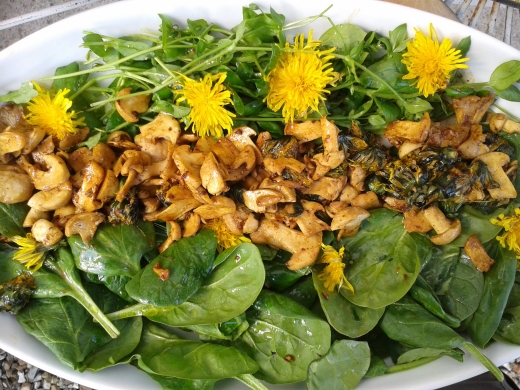
A warm tossed St. George’s salad
Also highly prized at this time of the year are the elusive morels, often appearing in limestone woods and on sandy soils during the spring. The caps of these fungi, (there are several species) have an irregular honeycomb like appearance and the cap and stem are hollow. They are difficult to find but highly regarded as a cooking ingredient.
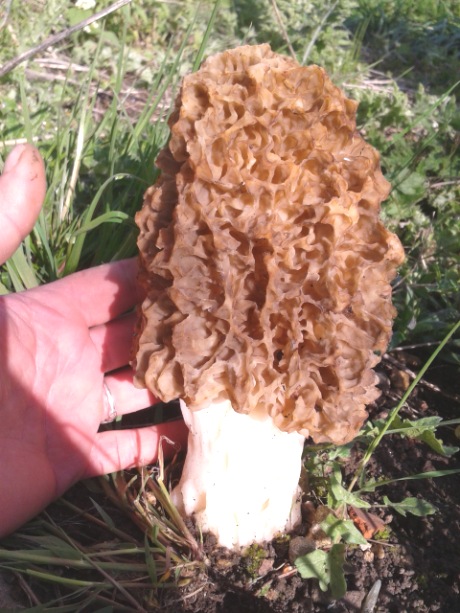
Morchella esculenta – Edible morel
Morels should be dried for storage and re-hydrated using warm water, herbs and a little salt for half an hour or so before cooking as this improves their flavour considerably. They go well with cream based sauces and add something very special to many dishes. Fresh morels can also be stuffed – one popular recipe uses crab meat, egg, mayonnaise and breadcrumbs – and baked for 15 minutes at 180°C. Be sure of your identification and do not confuse them with the poisonous gyromitra or turban fungus that looks a bit similar. Never eat morels raw as occasionally this has caused poisoning! Once again, if in doubt a visit to an expert is required.
If you’d like to sample the joy of Finding your own St. George’s mushrooms then why not try out our St. George’s Mushroom Champagne Picnic on Saturday 7th May 2016. You can find out about it here.
//www.rogersmushrooms.com/gallery/DisplayBlock~bid~5697.asp
//www.rogersmushrooms.com/gallery/DisplayBlock~bid~6466~source~gallerychooserresult.asp
//en.wikipedia.org/wiki/Khidr
//en.wikipedia.org/wiki/Saint_George#Interfaith_Shrine
//www.saudiaramcoworld.com/issue/197106/st.george.the.ubiquitous.htm

